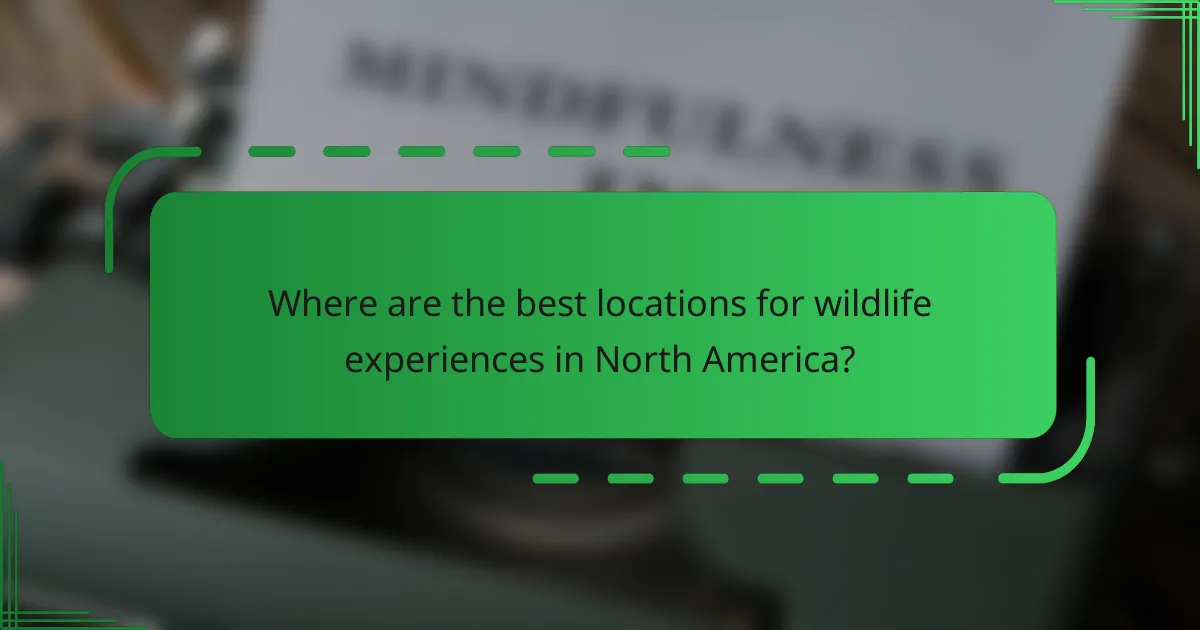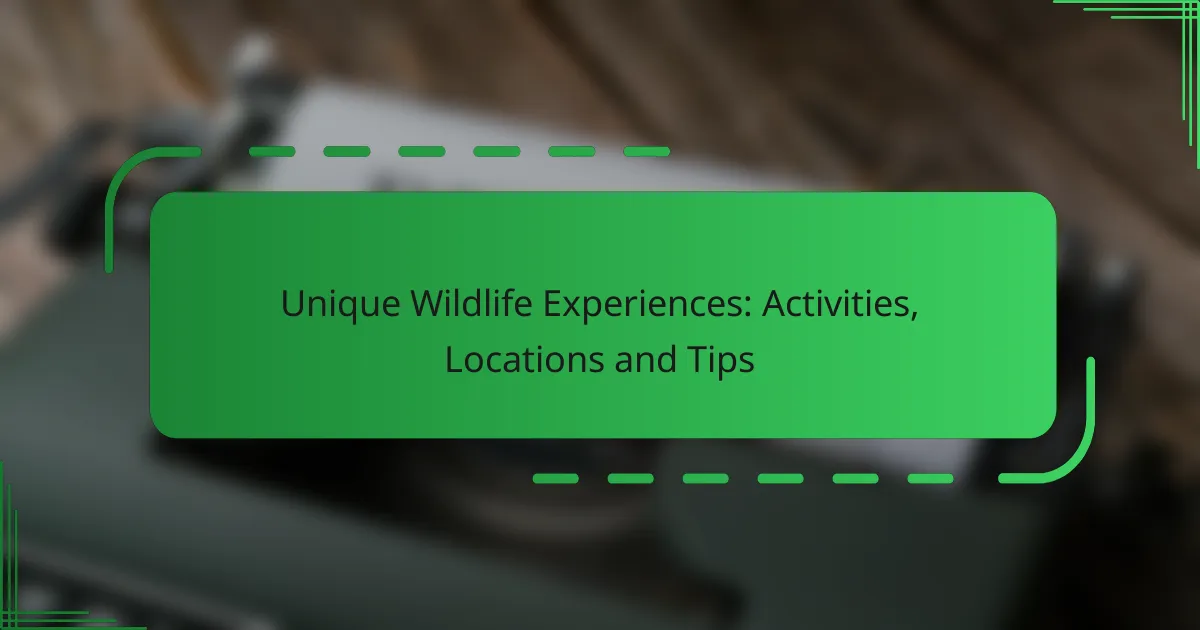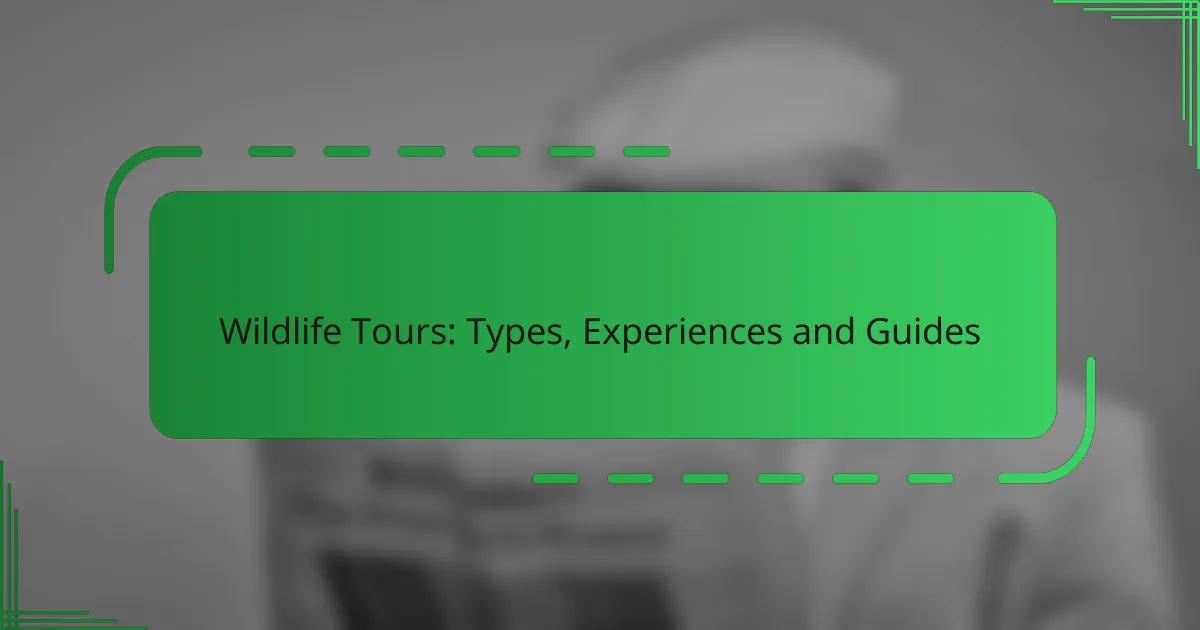Embarking on unique wildlife experiences allows you to connect with nature and witness incredible species in their natural environments. From the thrilling safaris of Africa to the breathtaking national parks of North America, these adventures promise unforgettable encounters. Proper preparation, including understanding local regulations and packing essential gear, is key to maximizing your wildlife journey.

What unique wildlife activities can I experience in Africa?
Africa offers a variety of unique wildlife activities that allow travelers to engage closely with nature and observe diverse species in their natural habitats. From thrilling safaris to intimate gorilla treks, these experiences provide unforgettable encounters with some of the world’s most remarkable animals.
Safari tours in Kruger National Park
Safari tours in Kruger National Park are among the most popular wildlife experiences in Africa. Visitors can choose between guided tours or self-drive options, allowing for flexibility in exploring the park’s vast landscapes and diverse ecosystems.
During a safari, expect to see the Big Five—lion, leopard, elephant, buffalo, and rhinoceros—along with numerous other species. The best time for wildlife viewing is during the dry season, from May to September, when animals congregate around water sources.
To enhance your safari experience, consider booking a night drive or a walking safari for a different perspective. Always remember to follow park regulations and respect wildlife by maintaining a safe distance.
Gorilla trekking in Uganda
Gorilla trekking in Uganda offers a rare opportunity to observe mountain gorillas in their natural habitat. The most popular locations for trekking are Bwindi Impenetrable National Park and Mgahinga Gorilla National Park, where guided treks lead you through dense forests.
Permits for gorilla trekking are required and can be quite competitive, often costing several hundred USD. It’s advisable to book these permits well in advance, as only a limited number are issued each day to minimize human impact on the gorillas.
Be prepared for a physically demanding trek that can last several hours, and wear appropriate clothing and sturdy footwear. Respecting the gorillas’ space is crucial; maintaining a distance of at least seven meters is mandatory to protect both visitors and the animals.
Whale watching in Hermanus
Whale watching in Hermanus is a premier activity along South Africa’s southern coast, particularly between June and December when southern right whales migrate to the area. This coastal town is renowned for its land-based whale watching opportunities, allowing visitors to spot these magnificent creatures from various vantage points.
Boat tours are also available for a closer encounter, providing a unique perspective of the whales breaching and swimming. Ensure that the tour operator follows responsible whale watching guidelines to minimize disturbance to the animals.
When planning your trip, consider the best viewing spots, such as the Cliff Path, which offers stunning views and is easily accessible. Bring binoculars for a better experience, and remember to respect local regulations regarding marine wildlife.
Birdwatching in the Okavango Delta
Birdwatching in the Okavango Delta is a rewarding experience, attracting enthusiasts from around the globe. This UNESCO World Heritage site is home to over 400 bird species, making it one of the best birding destinations in Africa.
The best time for birdwatching is during the wet season, from November to March, when migratory birds arrive and the landscape is lush. Guided birdwatching tours are available, offering expert insights into the diverse avian life and their habitats.
To maximize your birdwatching experience, bring a good pair of binoculars and a field guide to help identify species. Be mindful of your surroundings and practice patience, as some of the most beautiful birds can be elusive.

Where are the best locations for wildlife experiences in North America?
The best locations for wildlife experiences in North America include national parks renowned for their diverse ecosystems and abundant animal populations. These parks offer unique opportunities to observe wildlife in their natural habitats, making them ideal for nature enthusiasts and photographers alike.
Yellowstone National Park
Yellowstone National Park is famous for its geothermal features and rich wildlife, including bison, elk, and wolves. Visitors can explore various trails and viewpoints to catch glimpses of these animals, particularly in the Lamar Valley and Hayden Valley.
To enhance your experience, consider visiting during early morning or late afternoon when animals are most active. Be sure to maintain a safe distance and follow park guidelines to protect both yourself and the wildlife.
Everglades National Park
Everglades National Park offers a unique ecosystem characterized by wetlands and subtropical wildlife. Here, you can encounter alligators, manatees, and a variety of bird species, making it a prime location for wildlife viewing and photography.
Guided airboat tours or kayak excursions can provide closer encounters with wildlife while ensuring safety and respect for the environment. Remember to bring sunscreen and insect repellent, as the subtropical climate can be challenging.
Denali National Park
Denali National Park is home to North America’s highest peak and a diverse range of wildlife, including grizzly bears, moose, and caribou. The park’s vast wilderness allows for excellent wildlife viewing opportunities, particularly along the Denali Park Road.
Plan your visit during the summer months for the best chances to see animals. Consider taking a bus tour to access remote areas of the park while learning from knowledgeable guides. Always keep a safe distance from wildlife and adhere to park regulations to ensure a safe experience.

How can I prepare for a wildlife adventure?
Preparing for a wildlife adventure involves understanding local regulations, packing the right gear, and ensuring safety and health precautions. This preparation will enhance your experience and help you navigate potential challenges effectively.
Research local wildlife regulations
Before embarking on your wildlife adventure, familiarize yourself with local wildlife regulations. These rules can vary significantly by region and may include restrictions on animal interactions, permitted activities, and conservation efforts.
Check government websites or local wildlife agencies for specific guidelines. For example, in national parks, there may be strict rules about feeding animals or venturing off designated trails to protect both wildlife and visitors.
Pack appropriate gear
Choosing the right gear is essential for a successful wildlife experience. Depending on your destination, this may include binoculars for birdwatching, a camera with a zoom lens, and appropriate clothing for varying weather conditions.
Consider packing items such as sturdy hiking boots, a first-aid kit, insect repellent, and a reusable water bottle. Always check the climate and terrain of your destination to ensure you have suitable equipment.
Plan for safety and health precautions
Safety and health should be top priorities during your wildlife adventure. Research potential hazards in the area, such as dangerous animals or plants, and prepare accordingly. Carry a map, a compass, or a GPS device to avoid getting lost.
Additionally, ensure you have necessary vaccinations and medications, especially if traveling to remote areas. It’s wise to inform someone about your itinerary and expected return time for added safety.

What tips can enhance my wildlife viewing experience?
Enhancing your wildlife viewing experience involves planning, patience, and respect for nature. By considering the right timing, using equipment effectively, and maintaining a respectful distance, you can significantly improve your chances of memorable encounters.
Best times for wildlife sightings
The best times for wildlife sightings typically occur during early mornings and late afternoons when animals are most active. Depending on the species and location, these peak times can vary, so researching specific wildlife behavior in your area is beneficial.
Seasons also play a crucial role; for instance, spring often brings more visible activity as animals emerge from hibernation or are raising young. In contrast, winter may offer unique opportunities to spot animals in snowy landscapes.
Using binoculars and cameras effectively
To maximize your wildlife viewing, invest in a good pair of binoculars with a magnification of at least 8x and a wide field of view. This allows you to observe animals from a distance without disturbing them. Practice using your binoculars before your trip to become familiar with their settings.
When photographing wildlife, use a camera with a decent zoom lens to capture details without getting too close. Keep your camera settings ready for quick adjustments, as wildlife can be unpredictable and fleeting.
Respecting wildlife and their habitats
Respecting wildlife means observing from a distance and avoiding actions that could disturb their natural behavior. Always adhere to local guidelines regarding proximity to animals, which often recommend staying at least 100 meters away from large mammals.
Additionally, be mindful of the environment by sticking to marked trails and not littering. This helps protect habitats and ensures that wildlife can thrive for future generations of viewers.

What are the ethical considerations for wildlife tourism?
Ethical considerations in wildlife tourism focus on minimizing harm to animals and their habitats while promoting conservation and local communities. Tourists should prioritize experiences that respect wildlife and contribute positively to conservation efforts.
Choosing responsible tour operators
Selecting responsible tour operators is crucial for ethical wildlife tourism. Look for companies that adhere to established guidelines, such as those set by the Global Sustainable Tourism Council or similar organizations. These operators often prioritize animal welfare, employ local guides, and support conservation initiatives.
Before booking, research the operator’s practices. Check for certifications, read reviews, and inquire about their policies on wildlife interactions. Responsible operators typically avoid activities that exploit animals, such as feeding or riding, and instead focus on observation in natural settings.
Understanding wildlife conservation impacts
Wildlife tourism can have significant conservation impacts, both positive and negative. On one hand, it can generate funding for conservation projects and raise awareness about endangered species. On the other hand, poorly managed tourism can lead to habitat destruction and stress for wildlife.
To understand these impacts, consider the balance between tourism and conservation. Support initiatives that reinvest a portion of profits into local conservation efforts. Engage with local communities to ensure that tourism benefits them directly, fostering a sustainable relationship between wildlife, tourists, and residents.

How can technology improve wildlife experiences?
Technology enhances wildlife experiences by providing tools that facilitate tracking, observation, and immersive interactions. These advancements allow enthusiasts to connect with nature in innovative ways, making wildlife encounters more accessible and informative.
Wildlife tracking apps
Wildlife tracking apps are designed to help users locate and monitor animal movements in real-time. These applications often utilize GPS technology and user-generated data to provide insights into wildlife behavior and migration patterns.
Popular apps like iNaturalist and Seek allow users to identify species and contribute to citizen science projects. When using these apps, consider the accuracy of the data and the privacy policies regarding location sharing.
- Check for offline capabilities if you are in remote areas.
- Look for apps that include community features for sharing experiences.
- Ensure the app is compatible with your device’s operating system.
Virtual reality wildlife experiences
Virtual reality (VR) wildlife experiences offer immersive simulations that allow users to explore natural habitats and observe animals without leaving home. These experiences can range from guided tours in national parks to interactive wildlife documentaries.
VR can be particularly beneficial for educational purposes, providing a safe environment to learn about ecosystems and conservation efforts. When selecting a VR experience, consider the quality of the graphics and the realism of the interactions.
- Invest in a good VR headset for the best experience.
- Look for experiences that include educational content to enhance learning.
- Be mindful of motion sickness; start with shorter sessions if you are new to VR.



